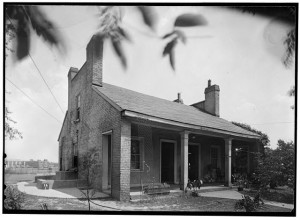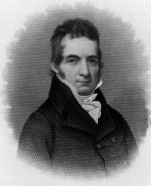The Landed Gentry: Kienlen and Wells Establish Estates
In the spring of 1837, Christopher Kienlen bought 200 acres in the wilderness north of the St. Charles Road. He built a large brick mansion in the middle of the farm, at what is now Kienlen and Wellsmar Avenues. He lived on the estate with his wife and four children. The southern boundary of the farm was the St. Charles Rock Road, while the western edge was marked by Ames Woods. The estate reached north a bit past St. Louis Avenue and stretched east to Hodiamont Avenue.
Later, the old driveway from the St. Charles Rock Road to the Kienlen mansion was named Kienlen Avenue and extended through Natural Bridge Road. When Kienlen died, his widow divided the estate between herself and their children. In 1868, she sold 66 acres of the land to Erastus Wells for $17,000.
In 1868, Wells established his country home in this area with the land he had purchased from Kienlen’s widow. His son, Rolla Wells, who later became known as St. Louis’s World’s Fair Mayor, described the estate in his memoirs. He writes:
In 1868 my father purchased 66 acres of land in St. Louis County, fronting on the North Side of St. Charles Rock Road and extending northwardly, which was used as our country home. This tract of land is now a part of Wellston which was named for my father. We did not have the conveniences of the present day. There were no electric lights, gas, telephone, or community water supply. The roads leading to and from the City were the St. Charles Rock Road and some parallel and intersecting dirt roads, a portion of which frequently crossed private property as a day for my mother to go in our carriage to the city for shopping or social functions. This country place was the source of much pleasure and recreation for my father. He enjoyed the products of the orchard, the vineyard, the melon patch, and the garden. The Sunday afternoon visits of his friends were especially enjoyable, they sitting in the shade of the trees, talking and joking. Well do I remember the joyous shouts and laughter of the thousands of children who were transported to their annual picnic outings on the Narrow Gauge Railroad. A few years after the death of my father in 1893 the house caught fire and burned. It seems to me almost incredible now that this section is made up of intersecting, smoothly paved streets and alleys, and block after block of residences and other structures.
Wells was married twice. In 1850, he married Miss Isabella R. Henry (for whom Isabella Avenue was named). After Isabella’s death, Wells married Mrs. Eleanor P. Bell; this second marriage took place in 1869.
Soon after Wells established his estate, other well-to-do St. Louisans began building in the area as well, making it a popular country estate and suburban region. Figures such as the prominent lawyer Alonzo W. Slayback lived quite close to Wells, and the Ringrose Watsons had a country home called Fruit Hill—located just across St. Charles Road from Wells.
Street names and place names still tell the story of Erastus Wells and his early country neighbors. Wells certainly left his impact. Not only was the community eventually named after him, but a number of streets were also named for him: Wells Avenue, Wellsmar Avenue, Wellston Place, and Wellston Avenue. In fact, a series of streets—Ella Avenue, Myrtle Avenue, and Audrey Avenue—were said to be named for Wells’s sisters.
But other wealthy St. Louisans who were beginning to establish themselves in the Wellston area also began to leave legacies in the names of Wellston and St. Louis streets and attractions. For example:
- To the west of Wells, James H. Lucas had an estate as did his sister, Ann Lucas Hunt, for whom Lucas and Hunt Road was named.
- To the east, George Rinkel operated a tavern known as the “Seven Mile House,” so called because of its distance from the St. Louis City Courthouse. A small collection of houses that had built up around the tavern came to be known as Rinkelville. Later, Rinkel’s Grove, an amusement park, would be established there.
- Other neighbors were the Goodfellows who had a very large farm along a lane which is now known as Goodfellow Avenue.
- Just east of Fruit Hill was DeHodiamont’s Road (later Hodiamont Avenue) which led to Emanuel DeHodiamont’s farm some distance to the south.
- Rose Hill on St. Charles Road was the country home of Hamilton R. Gamble, a lawyer, Supreme Court judge, and Governor of Missouri. Hamilton Avenue was later named for him. In a pamphlet written in 1951 about Wellston, McCune Gill wrote, “Hamilton Avenue now runs through this tract and with Hodiamont Avenue and St. Charles Road form the ‘crossroads’ or traffic intersection that has caused the business center of Wellston to develop.”
- Rufus Easton, a lawyer, banker, and postmaster of St. Louis, retired to St. Charles to live with his daughter, Mrs. Mary Easton Sibley (who founded Lindenwood College). The eastern end of St. Charles Road was named Easton Avenue.
Although the suburban/country area just west of the St. Louis city limits was defined in many ways by the presence of Erastus Wells and his family, it was full

Dr. O’Brien House, 1232 Sutter Avenue, built 1819 (Historic American Buildings Survey, HABS #116, Library of Congress)
of the country estates and farms of other wealthy St. Louisans, and the region was not yet thought of as the Wellston area. However, in 1876, an issue surfaced that was to be a key problem for the rest of Wellston’s history. Gill, in his 1951 pamphlet, describes the situation:
In 1876 the country squires and the owners of the few houses built on lots near St. Charles Road were startled to find that their community had been divided by a constitutional line leaving some of them still in St. Louis County with low assessments and high tax rates, and putting others in the new City of St. Louis with high assessments and low tax rates. But the county Wellstonians didn’t care. On the contrary they rather liked being free from municipal regulation.
The early phase of what would eventually become formally known as Wellston came to an end in 1893, with the death of Erastus Wells. His house burned completely to the ground shortly after his death.
Next.

